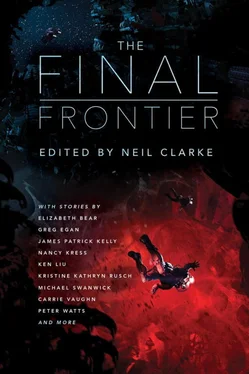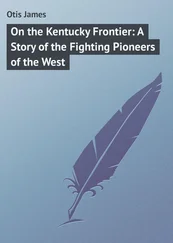On my screen, the counter ticks away the minutes.
Our argument isn’t forgotten, but it’s on hold as the first members of our little unit vanish inside.
After thirty-five minutes—fifteen of them inside (Jypé has rigorously stuck to the schedule on each of his dives, something which has impressed me)—I start to get nervous.
I hate the last five minutes of waiting. I hate it even more when the waiting goes on too long, when someone doesn’t follow the timetable I’ve devised.
Squishy, who’s never been in the skip with me, is pacing. She doesn’t say any more—not about danger, not about the way I’m running this little trip, not about the wreck itself.
I watch her as she moves, all grace and form, just like she’s always been. She’s never been on a real mystery run. She’s done dangerous ones—maybe two hundred deep space dives into wrecks that a lot of divers, even the most greedy, would never touch.
But she’s always known what she’s diving into, and why it’s where it is.
Not only are we uncertain as to whether or not this is an authentic Dignity Vessel (and really, how can it be?), we also don’t know why it’s here, how it came here, or what its cargo was. We have no idea what its mission was either—if, indeed, it had a mission at all.
37:49
Squishy’s stopped pacing. She looks out the portals again, as if the view has changed. It hasn’t.
“You’re afraid, aren’t you?” I ask. “That’s the bottom line, isn’t it? This is the first time in years that you’ve been afraid.”
She stops, stares at me as if I’m a creature she’s never seen before, and then frowns.
“Aren’t you?” she asks.
I shake my head.
The handheld springs to life, images bouncy and grainy on the corner of my screen. My stomach unclenches. I’ve been breathing shallowly and not even realizing it.
Maybe I am afraid, just a little.
But not of the wreck. The wreck is a curiosity, a project, a conundrum no one else has faced before.
I’m afraid of deep space itself, of the vastness of it. It’s inexplicable to me, filled with not just one mystery, but millions, and all of them waiting to be solved.
A crackle, then a voice—Jypé’s.
“We got a lot of shit.” He sounds gleeful. He sounds almost giddy with relief.
Squishy lets out the breath she’s obviously been holding.
“We’re coming in,” Junior says.
It’s 40:29.
The wreck’s a Dignity Vessel, all right. It’s got a DV number etched inside the hatch, just like the materials say it should. We mark the number down to research later.
Instead, we’re gathered in the lounge, watching the images J&J have brought back.
They have the best equipment. Their suits don’t just have sensors and readouts, but they have chips that store a lot of imagery woven into the suits’ surfaces. Most suits can’t handle the extra weight, light as it is, or the protections to ensure that the chips don’t get damaged by the environmental changes—the costs are too high, and if the prices stay in line, then either the suits’ human protections are compromised, or the imagery is.
Two suits, two vids, so much information.
The computer cobbles it together into two different information streams—one from Jypé’s suit’s prospective, the other from Junior’s. The computer cleans and enhances the images, clarifies edges if it can read them and leaves them fuzzy if it can’t.
Not much is fuzzy here. Most of it is firm, black-and-white only because of the purity of the glovelights and the darkness that surrounds them.
Here’s what we see:
From Junior’s point-of-view, Jypé going into the hatch. The edge is up, rounded, like it’s been opened a thousand times a day instead of once in thousands of years. Then the image switches to Jypé’s legcams and at that moment, I stop keeping track of which images belong to which diver.
The hatch itself is round, and so is the tunnel it leads down. Metal rungs are built into the wall. I’ve seen these before: they’re an ancient form of ladder, ineffective and dangerous. Jypé clings to one rung, then turns and pushes off gently, drifting slowly deep into a darkness that seems profound.
Numbers are etched on the walls, all of them following the letters DV, done in ancient script. The numbers are repeated over and over again—the same ones—and it’s Karl who figures out why: each piece of the vessel has the numbers etched into it, in case the vessel was destroyed. Its parts could always be identified then.
Other scratches marked the metal, but we can’t read them in the darkness. Some of them aren’t that visible, even in the glovelights. It takes Jypé a while to remember he has lights on the soles of his feet as well—a sign, to me, of his inexperience.
Ten meters down, another hatch. It opens easily, and ten meters beneath it is another.
That one reveals a nest of corridors leading in a dozen different directions. A beep resounds in the silence and we all glance at our watches before we realize it’s on the recording.
The reminder that half the dive time is up.
Junior argues that a few more meters won’t hurt. Maybe see if there are items off those corridors, something they can remove, take back to the Business and examine.
But Jypé keeps to the schedule. He merely shakes his head, and his son listens.
Together they ascend, floating easily along the tunnel as they entered it, leaving the interior hatches open, and only closing the exterior one, as we’d all learned in dive training.
The imagery ends, and the screen fills with numbers, facts, figures and readouts which I momentarily ignore. The people in the room are more important. We can sift through the numbers later.
There’s energy here—a palpable excitement—dampened only by Squishy’s fear. She stands with her arms wrapped around herself, as far from Turtle as she can get.
“A Dignity Vessel,” Karl says, his cheeks flushed. “Who’d’ve thought?”
“You knew,” Turtle says to me.
I shrug. “I hoped.”
“It’s impossible,” Jypé says, “and yet I was inside it.”
“That’s the neat part,” Junior says. “It’s impossible and it’s here.”
Squishy is the only one who doesn’t speak. She stares at the readouts as if she can see more in them than I ever will.
“We have so much work to do,” says Karl. “I think we should go back home, research as much as we can, and then come back to the wreck.”
“And let others dive her?” Turtle says. “People are going to ghost us, track our research, look at what we’re doing. They’ll find the wreck and claim it as their own.”
“You can’t claim this deep,” Junior says, then looks at me. “Can you?”
“Sure you can,” I say. “But a claim’s an announcement that the wreck’s here. Something like this, we’ll get jumpers for sure.”
“Karl’s right.” Squishy’s voice is the only one not tinged with excitement. “We should go back.”
“What’s wrong with you?” Turtle says. “You used to love wreck diving.”
“Have you read about early period stealth technology?” Squishy asks. “Do you have any idea what damage it can do?”
Everyone is looking at her now. She still has her back to us, her arms wrapped around herself so tightly her shirt pulls. The screen’s readout lights her face, but all we can see are parts of it, illuminating her hair like an inverse nimbus.
“Why would you have studied stealth tech?” Karl asks.
“She was military,” Turtle says. “Long, long ago, before she realized she hates rules. Where’d you think she learned field medicine?”
“Still,” Karl says, “I was military too—”
Which explained a lot.
Читать дальше












